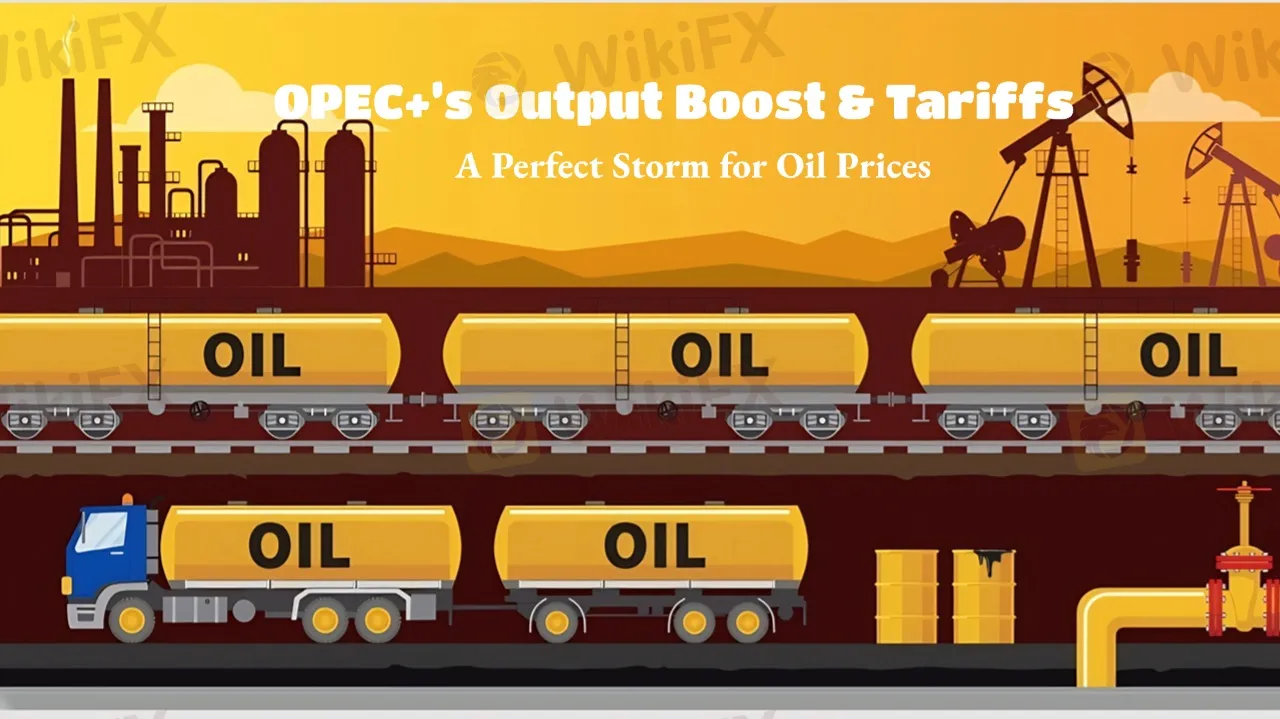简体中文
繁體中文
English
Pусский
日本語
ภาษาไทย
Tiếng Việt
Bahasa Indonesia
Español
हिन्दी
Filippiiniläinen
Français
Deutsch
Português
Türkçe
한국어
العربية
OPEC+’s Output Boost & Tariffs: A Perfect Storm for Oil Prices
Abstract:Oil prices have been on a continuous decline, and with the combined pressure of OPEC+ production increases and tariff policies, the downward trend may persist in the short term.

On March 4, Brent crude briefly fell below the $70 mark for the first time since October last year, while WTI crude dropped below $67, hitting a three-month low.
During Mondays meeting, OPEC+ announced its first crude oil production increase since 2022, planning to raise output by 138,000 barrels per day starting in April.
This decision signals a gradual rollback of the groups previous policy, which had reduced daily production by six million barrels to stabilize the market. This move is expected to further weaken oil price support and heighten the risk of supply-demand imbalances.
Beyond the pressure from increased production, trade policies are also adding to market uncertainty. The Trump administration has imposed a 25% tariff on goods from Mexico and Canada, while raising tariffs on Chinese goods to 20%.
This decision has fueled fears of an escalating global trade war, which could dampen energy demand and exert additional downward pressure on oil prices.
Amid deteriorating supply-demand dynamics, market expectations for oil prices remain pessimistic. Citi forecasts that Brent crude prices may decline toward $60 per barrel over the next three months. Goldman Sachs analysts also warn that with higher-than-expected crude supply, slowing U.S. economic activity, and demand contraction due to escalating tariffs, oil prices face significant downside risks.
Disclaimer:
The views in this article only represent the author's personal views, and do not constitute investment advice on this platform. This platform does not guarantee the accuracy, completeness and timeliness of the information in the article, and will not be liable for any loss caused by the use of or reliance on the information in the article.
Read more

TradingPRO: A Closer Look at Its Licences
In an industry where safety and transparency are essential, the regulatory status of online brokers has never been more important. For traders seeking to protect their capital, ensuring that a platform operates under recognised and stringent oversight can make all the difference. Keep reading to learn more about TradingPRO and its licenses.

Oil Price Breakout Incoming? Investors Should Stay Alert
Oil prices are hovering around a critical level, with potential yet to be fully unleashed. Investors must prepare for sudden changes.

New SEBI Regulations on Intraday Trading
The Securities and Exchange Board of India (SEBI) has implemented revised regulations on Intraday trading, with effect from November 20, 2024. These regulations are meant to lessen risks and prevent speculative trading practices.

Top Forex Trading Strategies Every Trader Must Implement
Successfully navigating the fluctuating forex market landscape requires more than having a high-risk appetite. It requires effective strategies that assure you gains even during the market fall. Let’s go through the strategies many traders implement to gain.
WikiFX Broker
Latest News
eToro Review 2025: Top Trading Opportunities or Hidden Risks?
How much money will you earn by investing in Vantage Broker?
IronFX vs Exness Review 2025: Comprehensive Broker Comparison
Fraudsters Are Targeting Interactive Brokers' Users with Lookalike Emails
Interactive Brokers: Global Office Visits and Licensing Details
Top Tips to Choose the Best Forex Broker in 2025
SEBI Notifies New F&O Rules for Investors - New Derivative Trading Limits & More Amendments
ASIC Urges Financial Licensees to Fix Register Errors Before 2026 Deadline
U.S. Jobs Data Released: A Potential Boost for Gold Prices
SkyLine Guide 2025 Malaysia: 100 Esteemed Judges Successfully Assembled
Currency Calculator


